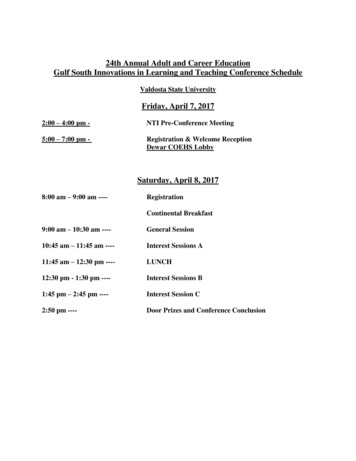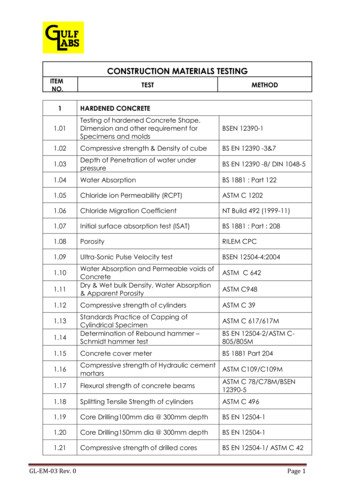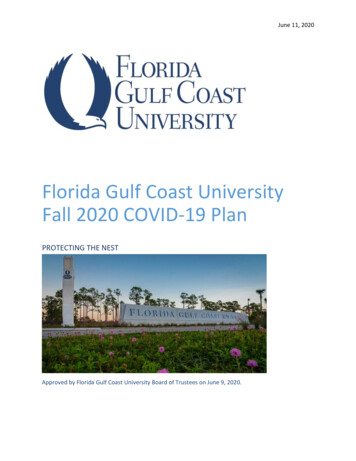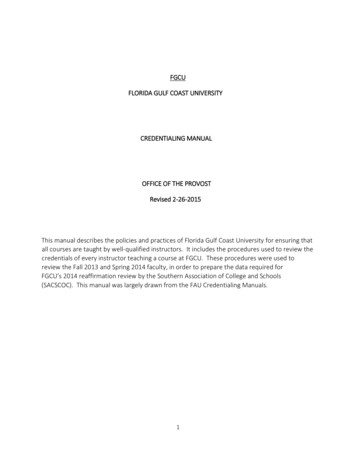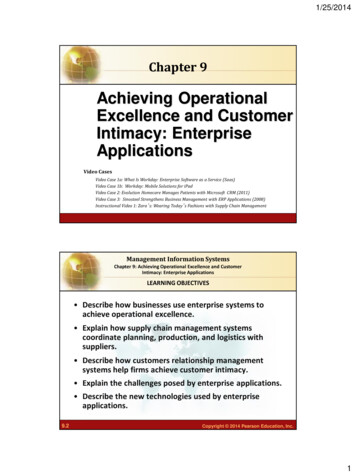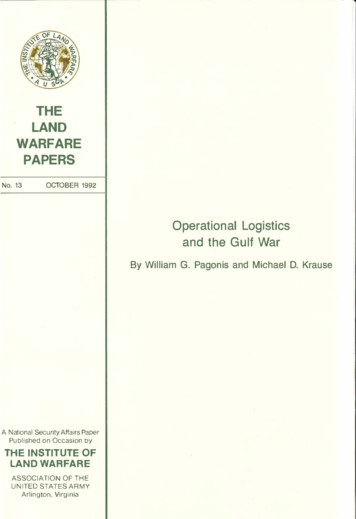
Transcription
THELANDWARFAREPAPERSNo. 13OCTOBER 1992Operational Logisticsand the Gulf WarBy William G. Pagonis and Michael D. KrauseA National Security Affairs PaperPublished on Occasion byTHE INSTITUTE OFLAND WARFAREASSOCIATION OF THEUNITED STATES ARMYArlington, Virginia
lOPERATIONAL LOGISTICS AND THE GULF WARbyWilliam G. PagonisandMichael D. KrauseThe Institute of Land WarfareASSOCIATION OF THE UNITE D STATES ARMY
AN AUSA INSTITUTE OF LAND WARFARE PAPERIn 1988 the Association of the United States Army (AUSA) established within itsexisting organization a new entity known as the Institute of Land Wanare. Its purpose isto extend the educational work of AUSA by sponsoring scholarly publications, to includebooks, monographs and essays on key defense issues, as well as workshops and symposiaA work selected for publication as a LandWarfare Paper represents research by the authorwhich, in the opinion of the editorial board, will contribute to a better understanding of aparticular defense or national security issue. Publication as an AUSA Institute of LandWarfare Paper does not indicate that the Association of the United States Army agrees witheverything in the paper, but does suggest that the AUSA believes the paper will stimulatethe thinking of AUSA members and others concerned about important defense issues.LAND WARFARE PAPER N0.13, OCTOBER 1992OPERATIONAL LOGISTICS AND THE GULF WARbyWilliam G. PagonisandMichael D. KrauseThe paper represents the personal opinions of the authors and should not be takento represent the views of the Department of the Army, the Department of Defense, theInstitute of Land Warfare, the Association of the United States Army or its members. Copyright 1992 bythe Association of the United States Army(AUSA)All rights reserved. No parts of this publication may be reproduced, stored in aretrieval system or transmitted in any form or by any means, electronic, mechanical,photocopying, recording or otherwise, without the prior written permission of the AUSAInstitute of Land Warfare, 2425 Wilson Boulevard, Arlington, VA 22201.Inquiries regarding this and future Land Warfare Papers should be directed to:Association of the United States Army, Institute of LandWarfare, 2425WilsonBoulevard,Arlington, Virginia 22201, telephone 1-800-336-4570, or (703) 841-4300, extension 320.ii
-------,CONTENTSForeword .vIntroductionTheFramework of Operational Art.Logistics ofForward-Deployed and Power-ProjectionForcesTheater Setting and ObjectivesIntelligence and DeceptionOperationalFires.Command.Operational Logistics: Some ObservationsBibliographyThe Authors. . . . . .1.5.Concept of Operations and Scheme audi Arabia . viDesert Shield: Major Supply Routes and Logistical Basesiii.7
-----------FOREWORDThe Gulf War was underwritten by logistics. Building the Southwest Asia theaterinfrastructure, deploying U.S. forces, sustaining the campaign and bringing the forces andtheir materiel back home were major accomplishments. Key to Operations Desert Shieldand Desert Storm was the close coordination between the logistical and operationalcommands and the commanders' understanding that logistics must dovetail with themission and concept of operations of the projected force.Addressing the fundamentals of the operational art, LTG William G. ("Gus")Pagonis, the theater logistical commander in the Gulf War, and his logistics plans chief,Colonel Michael Krause, show how and why logistics must be part and parcel of theoperational concept. The theater mission, concept of operations and scheme of maneuverare examined to bring out the criticality of logistics in effecting surprise and deception.Concluding with a series of observations on the logistical operations of the war, the authorsmake it clear that operational logistics will be critical in future power projections of U.S.forces.In the final analysis, this paper serves notice that the study of the operational art mustencompass an appreciation for operational logistics on a par with that usually accorded theoperations of combat formations.I-m. .Jack N. MerrittGeneral, USA RetiredPresidentOctober 1992v
III------- 300m-----300kmNIRANe KKMCRiyadhe Medina e MeccaSAUDI ARABIA . .::::::YEMEN
OPERATIONAL LOGISTICS AND THE GULF WARIntroductionIn January 1991, one of the most successful wars in America's history commenced.Logisticians overcame in an extraordinary way what General H. Norman Schwarzkopf,the theater commander, called a " daunting task." Logistics did three things: built thetheater infrastructure, sustained a victorious military campaign, and closed out the theaterof war by bringing personnel and materiel home. The discussion that follows is based onthe assumption that the reader is familiar with the Desert Storm campaign. Therefore,details of tactical operations are omitted.At the start of the war, General Colin Powell, chairman of the Joint Chiefs of Staff,spoke in simple terms: "We are going to cut it off and kill it." Put into a military context,he revealed the operational concept for the upcoming campaign.This paper provides a framework for discussing the role of operational logistics inthe ground phase of the GulfWar. It addresses the essential logistical differences betweenforward-deployed forces and power-projection forces; the elements of operational art asthe connector between strategy and tactics; and logistics in an operational setting inSouthwest Asia. The conclusions suggest considerations of operational logistics whichwill be important in future deployments. Indirectly, closer integration of logistics intocampaign planning, particularly the concepts of operations, maneuver and reserves, issuggested.The Framework of Operational ArtDuring the last decade or so, the United States Army has rediscovered operationalart. In this period, major doctrinal changes have been introduced, debated and reformu lated. There has been a renaissance of thinking about the operational level of war andoperational art.Operational art is different from strategy and tactics. It holds to a different logic.The perspective of operational art is different as well. Operational art is the connectionbetween the aims of strategy and tactics. Strategy involves the conduct of warfare toaccomplish political and military aims. While tactics involves the conduct of battle toovercome and destroy the enemy, operational art contributes to the conduct of strategyby the achievement of military objectives. It differs from strategy by not having a politicalobjective.In the 19th century, German Field Marshal Helmuth von Moltke began todifferentiate among military strategy, operations and tactics. He recognized that strategy1
in war is inherently linked with the attainment of the political objective, and that operationalart defines military objectives which underpin the political objectives. His conduct ofoperations- his practice of the operational art- has been studied ever since. Germanusage and practice led to Russian-Soviet adoption of the operational art conceptin the 20thcentury. Rediscovery of the importance of the operational art for American and alliedforces is a consequence of the Cold War.The dimensions of war change among strategy, operations and tactics.Thestrategist aims at the enemy's center of gravity, be it a nation's will, the delicate seam ofan alliance or key resources. The operational center of gravity is the mass of enemy militaryforce and its command, control and communications.At the tactical level, the tactician has a more limited perspective.Tacticalcommanders are concerned with how to fight; operational commanders defme where andwhen to fight; and strategic commanders decide whether or not to fight.In tactics, maneuver and fires are mutually interdependent At the operational level,maneuver and fires are used to unbalance the enemy and achieve momentum and tempo.In tactics, intelligence is concerned with capabilities. At the operational level,intelligence is concerned more with intentions.Deception is used by the tacticalcomman der to hide forces. In the operational context, deception is used to hide intent andcause the enemy to reveal his intent.In operational art, the use of reserves is critical, but they are not the same reserves- an uncommitted ready force - thought of at the tactical level.Reserves at theoperational level should be thought of as the future use of forces which may or may notbe presently engaged. Also, at the operational level, logistics may be considered anotherform of reserve. At the strategic level, force generation capability and logistics are thereserves.At the tactical level, logistics is used to affect the battle in progress. However,logistics at the operational level is more than sustaining the force. Logistics is part of thecommander's concept of operations and scheme of maneuver. Logistics adds synergismto all of the elements of operational art and helps to underwrite campaigns.At the strategic level, the commander looks toward the outcome of campaigns ofthe war as a means of achieving policy objectives. His time horizon is distant. At theoperational level, the commander also looks to the future; he looks beyond the outcomeof battle. He is concerned with several moves ahead, in days, weeks and even months. Thetactical commander looks toward the outcome of engagements and battles in hours.The strategist formulates aims and generates capabilities; the operational com mander seeks unity of effort over time; the tactical commander orders immediate actionin the field of battle. Operational art involves a vision of unity of action which carries outthe strategic objectives.2
As the previous discussion points out, operational art is composed of differentperspectives. The elements of operational art- which are essential to its understanding-are outlined below. This framework is used in turn to measure operational logistics inthe Gulf War.Theater Setting: The strategic view of a theater of war holds to the political andmilitary objectives to be realized. The strategist sees the theater as a whole. Heviews the nature of its geography and the general nature of military forces in thetheater. The operational commander holds to a different view; he has to realizecertain military objectives. These objectives concern the capabilities of the opposingmilitary force, particularly the center of gravity of the opposing force, or its mass.The operational commander also looks to the geography of the theater in determin ing broad plans of action which will facilitate his concept of operations.Objectives: Policy dominates the conduct of warfare. Prussian general and militarystrategist Carl von Clausewitz reminds us: "Warfare is the continuation of politicsby other means." A nation-state's reason for going to war has a political and militaryobjective. The definition of national and political objectives and the determinationof the means to achieve them is strategy. The translation of military and politicalobjectives into military objectives in a theater of war is operational art.Concept of Operations: What makes for a successful campaign? How does acommander integrate and synchronize the diverse forces under his command anddirect them to carry out the mission? A commander thinks through the plan whichwill accomplish the operational objective and in tum will realize the strategic goal.The concept must convey his intent and insure unity of effort. The commander'sconcept of operation is the composer's score used to orchestrate the entire conductof play. Above all, the concept must be based on clear objectives. The commandermeasures his vision within the stretched capacity of logistical operations.Intelligence: the ability to see. This is not only what meets the eye but also the abilityto visualize the opponent's intent and capability. The commander who, in thiscontest of wills, thinks through what his opponent's interests and actions are, thecommander who does a hypothesis of enemy intentions, will be better prepared toaccomplish his own course of action. A commander may focus on answering thesequestions: Where are the enemy's reserves? When can they move? Does the enemyforce commander have a reserve? H not, is there an indication of main effort whichcan realize the creation of forces in future time?Deception: the ability to fool and not to be fooled. Deception is best when it causesthe opponent to convince himself of the certainty of his own actions; it is best whenit causes him to make choices. Deception is not merely "cover and concealment."Deception aims at causing surprise and creating ambiguity.3
Maneuver: This is more than just movement. It is a concept of the integrated useof various forces and functions to unhinge the enemy. Maneuver creates leveragewhich generates opportunity. Concepts of operation translated into schemes ofmaneuver present the opponent with difficult and unwanted choices which are keyin the creation of leverage. Maneuver uses all aspects of the application of force andinvolves the combination of fires, movement and reserves.Operational Fires: This element involves the integrated application of land, seaand air firepower to attain an objective. But operational fires are not just the massedapplication of artillery and air or naval supporting fires; rather, it is the applicationof frres on critical components of the enemy which cause him to quit. This is notjust "fire and movement" writ large; rather, it is an understanding of the combinationof speed of movement with delivery of frres. The concentration of frres can createleverage.Reserves: The strategist generates them, the operational commander creates themthrough future capabilities, and the tactical commander has them at the ready. Ineach case, reserves are critical to the outcome of the war, the campaign and thebattle. Forces in reserve placed at the right time and place, created from extant orgenerated forces, can decide the outcome of a campaign.Operational Logistics: Logistics provides the ability to mass combat power. Itis a way of structuring a battle, campaign or strategic setting. It is calculated tocreate possibilities for future force utilization. Logistics determines how, when andwhere the force arrives in a theater; where and when combat power can be massed.Logistics underwrites the concept of operations and the scheme of maneuver andis the fulcrum upon which leverage can be created.Command: This element involves the methodology for the integrated, orches trated and synchronized application of force. The commander is a composer andconductor; he is a chess player- playing multiple games on different boards. Thecommander must have vision, purpose, balance and concentration. The communi cation of the commander's intention through simple, crisp, common-sense directionmay be the key to a successful campaign. Command and operational art bring thelogic and perspective of theater warfare and the conduct of campaigns together.This framework of operational art can be used to measure operational logistics inthe GulfWar. The nature of forces to be employed must also be weighed in understandingthe role of operational logistics.4
Logistics of Forward-Deployed and Power-Projection ForcesInherent in the difference between power-projection and forward-deployed forcesis the maturity of the theater.In a theater where forces are forward deployed, theinfrastructure of the theater is known and their use is well planned. The logistical readinessof forward-deployed forces enables those forces to roll out of their different bases anddeploy into combat. Sustainment supplies, reserve stocks and spare sets of equipment areprepositioned with the forward-deployed force. A forward-deployed force is familiar withroad, rail, aerodromes, ports and infrastructure that have been used numerous times inpeacetime rehearsals. Contracts for services and supplies are established and exercised.Communications- telephone and radio-are well established, with satellite relay wherenecessary. All aspects of the logistical movement of forces and their sustainment andcontrol would be known, rehearsed and in readiness. Little would be unknown in thelogistical world, including that of the enemy.This is not necessarily true in the power projection of forces. The theater of war andtheater of operations may have only very recently entered the planning horizon. Thetheater may not have any U.S. forces near it or on the ground. The logistical infrastructure-the ports, rail, road, airports, telecommunication system-may be known only by studyconducted from afar. The plethora of things that go with living in a place where you expectto fight will simply not be there. Everything, including fuel, food, ammunition, transpor tation, communications equipment and maps, has to be brought with the force beingprojected into the theater. A thousand questions will be left unanswered. Will there beoff-loading ramps at the aerodromes? What types of cranes are available in the ports? Howmuch water can be provided? Are there military-specification or compatible fuel and oil?What personal hygiene facilities are there? Can an influx of troops-at surge rates of 5,000a day- be accommodated? Where will soldiers live, sleep, eat, work, shower and go tothe bathroom? Can a force coming from a distinct!y different climate function? How longwill it take for soldiers' equipment to arrive? What of cultural, religious and societaldifferences? How will soldiers be received into an entirely different culture? Thesequestions- in the broadest sense -indicate the potential unknown nature of the theaterlogistical infrastructure and critical shortfalls which may confront a power-projectionforce.In power projection, the operational commander- the theater commander-in-chief-is constrained by the strategic aspects of logistics. How much air- and sealift is availableand how much time is available? The national-level decisionmakers will be advised of howmuch lift to make available by doing a risk analysis. If speed is of the essence, emergencyauthority from the president may be required for allocation of civilian aircraft and ships.The next decision point involves the risks to be taken in projecting into the theater combatforces versus logistical or combat service support forces. Strategic considerations maydictate initial deployment of predominantly combat forces.5
Theater Setting and ObjectivesApplication of force in a theater is underwritten by logistics. The nature of thetheater will determine the nature of the logistical support. Logistics at the strategic levelinvolves determining how the force gets to the theater, what materiel it will bring, and howfast it gets into the theater; this is essentially a strategic movement problem. At theoperational level, logistics must be in consonance with the logic of the operational conceptThe logistics applications in Southwest Asia can be measured through use of theoperational framework described above.The strategic objectives of the GulfWar articulated by President Bush were to: freethe western hostages held by Iraq; defend Saudi Arabia; liberate Kuwait; and destroyweapons of mass destruction so as to increase the stability of the region.General Schwarzkopf, the theater commander, used these strategic objectives tofocus on the military objective to destroy the Iraqi military force. General Schwarzkopfpostulated the center of gravity of Iraqi forces to be two-fold: the Republican Guard core, well-equipped forces which supported the regime of Saddam Hussein- and thecommand and control infrastructure used by Saddam Hussein to control his military forces.Hence, the objective of the Central Command's theater campaign was to destroy the Iraqiforce after crippling Saddam Hussein's centralized command, control and communica tions.The first objective for General Schwarzkopf was to deter the Iraqi force frominvading Saudi Arabia. This was, after all, in consonance with the strategic military missionto defend the oil-rich nation. Saddam Hussein's forces in Kuwait, after occupation of thissmall sheikdom, could have continued their offensive down the Saudi Arabian coastalhighway aiming for the port ofDammam. The port of Jubail and oil-producing areas wouldhave fallen into Iraqi hands.What deterred Iraq from continuing the invasion? At this stage we do not knowexcept to point out that the application of power-projection forces- the quick responseof naval, air and ground forces - evidently made Saddam Hussein think twice aboutcontinuing his offensive. It may be that he never intended to invade Saudi Arabia. It maybe that he calculated the effects of exposure of the long logistical tail of his forces to alliedinterdiction. Certainly the use of allied naval and ground-based attack aircraft would havehad significant effect on the ability of Iraqi ground forces. But this is speculation.What is known is this: The fast application of strategic mobility- the staging ofair, naval and ground forces into the theater- accomplished the defense mission.Distances were immense- 8,000 miles by air and more than 10,000 miles by sea.The strategic lift was further engaged by activation of the civilian air reserve fleet and themilitary sealift reserve fleet. Over 10,000 air sorties and more than 500 ships brought theforce to the theater. Time was a critical factor. Prepositioned ships, which contained6
critical initial buildup items- ammunition, water purification equipment, port handlingequipment and other logistical materiel- facilitated this process.The incoming force used the existing airports of Dhahran, Riyadh and, to a lesserextent, King Khalid Military City (KKMC). At these airports, the problem became howto receive, stage and move forward the soldiers and airmen corning into the theater. Anational command authority decision to frrst send in combat forces made the logisticaleffort more difficult. In light of this decision, early-arriving theater logisticians recognizedthe need to use host nation support to the utmost.The host nation, Saudi Arabia, offered to meet the force's basic needs- food,water, fuel and shelter. But providing for the simple needs of 540,000 personnel was animmense undertaking. Organization of what would be provided by the Saudi governmentbecame a first priority. In-theater transportation already existed due to the large numberof civilian trucks used in Saudi Arabia for construction and transport. Trucks of alldescription, but particularly heavy equipment transporters, were contracted for thebuildup of the theater infrastructure and later for the sustainment of the ground campaign.Logistics at the operational level was defined by the nature of the theater and themilitary objectives. These were conditioned by the factors of time and space and the needfirst to deter and then to fight. These conditions underwrote the buildup of the theaterinfrastructure and reliance upon host nation support.(ROMEO)IRAQe (HOTEL)(NOVEMBER) 350MILESSAUDI ARABIA,i ---- 400 MILESDesert Shield: Major Supply Routes and Logistical Bases7
Concept of Operations and Scheme of ManeuverGeneral Schwarzkopf explained his concept of operations in a news briefing shortlyafter the victorious ground campaign. His concept was predicated on building up the force,first to deter the enemy from attacking (thereby gaining time) and then to defend. Eachday won time and gave credibility to deterrence. Time and deterrence also gained logisticaladvantage. As the buildup continued, the logistical advantage figured prominently in theevolving concept of operations for the campaign. Next would come an offensive option.Schwarzkopf's concept of operations: First, blind the enemy; if the enemy could notsee, he could not position his force to counter the allied blow. Next, have the enemy thinkthe allied forces were coming where he expected them to come: an assault from the PersianGulf into Kuwait, along with a land assault against the main Iraqi positions in occupiedKuwait, and a flanking attack via the Wadi al Batin to try to get around these positions.Let him fool himself into thinking what he was disposed to think in the first place. Use theair campaign to blind and cripple his command, control, communications and intelligencemediums, threaten an amphibious assault, attack the main Iraqi positions to hold them inplace, and then use the agility and punching power of two corps to outflank Iraqi forces.This would cut off and destroy the much vaunted Iraqi Republican Guard forces, theoperational reserves of the Iraqi army.This commander's concept was predicated on two logistical concepts: first, to buildlogistical bases which could support two corps from forward locations (the distances fromthe coastal ports and airbases- more than 350 miles- made these bases a prerequisitefor ground operations); and second, to move two corps which were malpositioned. (TheXVIII Airborne Corps to the east and the VII Corps to the west had to change positions.)These two logistical tasks, daunting in themselves, had to be done without leaving tracksin the desert.General Schwarzkopf's concept depended upon having the enemy fool himself. Thelogistical buildup of forward logistical bases, far to the west of the Wadi al Batin, even tothe west of King Khalid Military City and to the west of any combat forces, could be seen.The solution was not to start the buildup until the air campaign had blinded the Iraqis.Hence, the westward movement of supplies for the two corps could not start until theblinding had worked. Then, while the buildup was ongoing during the aerial assault, themovement of the two corps to their forward tactical positions could take place under theair umbrella. General Schwarzkopf's concept was predicated on logistics not revealinghis intent. While logistical forward bases were crucial to support the corps and themovement of the two corps was a necessity, the establishment of these bases and movementincident thereto could be detected and would signal intent.In fact, the building of the forward logistical bases and the westward movement ofthe two corps - crossing them in the process - was so incredible an undertaking thatallied commanders initially did not believe it could be done.8
On December 27, 1990, the Secretary of Defense and the chairman of the JointChiefs of Staff were briefed on the concept of operations by General Schwarzkopf inRiyadh. After General Schwarzkopf explained his "end-run concept," the commandersfrom the two Army corps, the Marines, the Air Force and the 22d Support Command(SUPCOM) presented their respective plans, in .broad conceptual terms, to support theflanking movement. The logistical plans paid particular attention to the crossing of the twocorps and the building of forward logistical bases to the west.Toward the end of the briefing, General Schwarzkopf indicated that nothing was tomove until after the January 1 5 expiration of the United Nations deadline for redeploymentof Iraqi forces from Kuwait. When a head start on the movement to get log bases in placewas requested, General Schwarzkopf spoke bluntly: "That's not possible. The entire planhinges on surprise and deception. If you start relocating your log bases tomorrow, we'drun a great risk of being detected. Hussein would shift his defenses westward. Or worse,he'd order his forces to attack before the deadline and preempt our strategy."He concluded, "What we need to know is exactly how long it will take to get thoselog bases out there, in position to support the flanking maneuver, assuming you startedmoving out on 1 6 January. . We'll meet again on Saturday [December 29] to discuss arevised plan to accommodate these new goals."The logisticians went back to the drawing board. After frantic efforts a revised planwas taken to Riyadh and, on December 29, the requested briefing took place. The briefingfollowed the format of the earlier briefing, with General Schwarzkopf's introductionincluding the comment that the president had been briefed on the end-run plan.Thecommander's staff representatives presented their plans. Most of these included morelogistical support than could be provided. The revised 2 1-day logistics plan needed to buildthe log bases and move the corps was then presented.This briefing of the logistics plan was a turning point. The other commanders ralliedto the 22d SUPCOM's support, sensing that, if all worked together, the logistical effortwould succeed. Almost as a sidebar, General Schwarzkopf reflected that if his command ers were skeptical about the plausibility of the logistical effort in supporting the conceptof operations, the enemy would be skeptical as well. In short, the magnitude of
lated. There has been a renaissance of thinking about the operational level of war and operational art. Operational art is different from strategy and tactics. It holds to a different logic. The perspective of operational art is different as well. Operational art is

